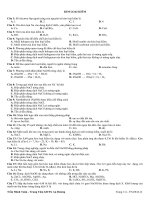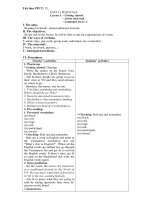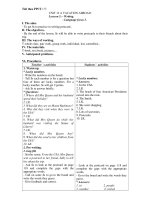Engine 2VZ FE
Bạn đang xem bản rút gọn của tài liệu. Xem và tải ngay bản đầy đủ của tài liệu tại đây (9.6 MB, 324 trang )
EM-1
ENGINE MECHANICAL – Description, Operation
ENGINE MECHANICAL
EM-2
ENGINE MECHANICAL – Description, Operation
DESCRIPTION
The 2VZ–FE engine is a V–6, 2.5 liter, DOHC 24–valve engine.
OPERATION
EM-2
ENGINE MECHANICAL – Description, Operation
DESCRIPTION
The 2VZ–FE engine is a V–6, 2.5 liter, DOHC 24–valve engine.
OPERATION
EM-3
ENGINE MECHANICAL – Operation
The 2VZ–FE engine has 6 cylinder in a V arrangement at a bank angle of 60°. From the front of the RH bank
cylinders are numbered 1 – 3 – 5, and from the front of the LH bank cylinders are numbered 2 – 4 – 6. The crankshaft is supported by 4 bearings inside the crankcase. These bearings are made of copper and lead alloy.
The crankshaft is integrated with 5 weights for balance. Oil holes are placed in the center of the crankshaft
for supplying oil to the connecting rods, pistons and other components.
This engine’s ignition order is 1 – 2 – 3 – 4 – 5 – 6. The cylinder head is made of aluminum alloy, with a cross
flow type intake and exhaust layout and with pent–roof type combustion chambers. The spark plugs are located
in the center of the combustion chambers.
At the front and rear of the intake port of the intake manifold, a water passage has been provided which connects the RH and LH cylinder heads.
Exhaust and intake valves are equipped with irregular pitch springs made of special valve spring carbon steel
which are capable of functioning no matter what the engine speed.
The RH and LH intake camshafts are driven by a single timing belt, and a gear on the intake camshaft engages with a gear on the exhaust camshaft to drive it. The camshaft journal is supported at 5 (intake) or 4 (exhaust) places between the valve lifters of each cylinder and on the front end of the cylinder head. Lubrication
of the cam journals and gears is accomplished by oil being supplied through the oiler port in the center of the
camshaft.
Adjustment of the valve clearance is done by means of an outer shim type system, in which valve adjusting
shims are located above the valve lifters. This permits replacement of the shims without removal of the camshafts.
The timing belt cover is composed of the resin type No.2 and No.1 above and below the engine RH mounting
bracket.
Pistons are made of high temperature–resistant aluminum alloy, and a depression is built into the piston head
to prevent interference with the valves.
Piston pins are the semi–floating type, with the pins fastened to the connecting rods by pressure fitting, allowing the pistons and pins to float.
The No.1 compression ring is made of steel and the No.2 compression ring is made of cast iron. The oil ring
is made of a combination of steel and stainless steel. The outer diameter of each piston ring is slightly larger
than the diameter of the piston and the flexibility of the rings allows them to hug the cylinder walls when they
are mounted on the piston. Compression rings No.1 and No.2 work to prevent gas leakage from the cylinder
and the oil ring works to clear oil off the cylinder walls to prevent it from entering the combustion chamber.
The cylinder block is made of cast iron with a bank angle of 60°. It has 6 cylinders which are approximately
twice the length of the piston stroke. The top of the cylinders is closed off by the cylinder heads and the lower
end of the cylinders becomes the crankcase, in which the crankshaft is installed. In addition, the cylinder block
contains a water jacket, through which coolant is pumped to cool the cylinders.
The oil pan is bolted onto the bottom of the cylinder block. The oil pan is an oil reservoir made of pressed
steel sheet. A dividing plate is included inside the oil pan to keep sufficient oil in the bottom of the oil pan even
when the vehicle is tilted. This dividing plate also prevents the oil from making waves when the vehicle is stopped
suddenly and thus shifting the oil away from the oil pump suction pipe.
EM-4
ENGINE MECHANICAL – Preparation
PREPARATION
SST (SPECIAL SERVICE TOOLS)
Illustration
Part No.
Part Name
09011–38121
12 mm Socket Wrench
for 12 Pointed Head
09201–41020
Valve Stem Oil Seal
Replacer
09201–70010
Valve Guide Bushing
Remover & Replacer
09202–70010
Valve Spring
Compressor
09213–54015
Crankshaft Pulley
Holding Tool
09213–60017)
Crankshaft Pulley &
Gear Puller Set
(09213–00020)
(Body with Bolt)
(09213–00030)
(Handle)
(09213–00060)
(Bolt Set)
09213–70010
Crankshaft Pulley
Holding Tool
09221–25024
Piston Pin Remover &
Replacer
(09221–00020)
(Body)
(09221–00030)
(Spring)
(09221–00181)
(Bushing “E”)
(09221–00190)
(Guide “K”)
Note
Connecting rod bolts
EM-5
ENGINE MECHANICAL – Preparation
SST (SPECIAL SERVICE TOOLS) (Cont’d)
Illustration
Part No.
(09221–00200)
Part Name
Note
(Guide “L”)
09223–46011
Crankshaft Front Oil
Seal Replacer
09223–56010
Crankshaft Rear Oil
Seal Replacer
09248–55010
Valve Clearance Adjust
Tool Set
09249–63010
Torque Wrench Adapter
09278–54012
Drive Shaft Holding Tool
09309–37010
Transmission Bearing
Replacer
09330–00021
Companion Flange
Holding Tool
09816–30010
Oil Pressure Switch
Socket
Crankshaft oil seal
Camshaft timing pulley
Crankshaft front oil seal
Crankshaft pulley
Knock sensor
RECOMMENDED TOOLS
Illustration
Part No.
Note
Part Name
For suspending engine
09090–04010
Engine Sling Device
09200–00010
Engine Adjust Kit
09258–00030
Hose plug Set
09904–00010
Expander Set
Plug for vacuum hose, fuel hose etc.
EM-6
ENGINE MECHANICAL – Preparation
EQUIPMENT
Part Name
Note
Caliper gauge
CO/HC meter
Compression gauge
Connecting rod aligner
Cylinder gauge
Dial indicator
Engine tune–up tester
Feeler gauge
Micrometer
Precision straight edge
Spring tester
Valve spring
Steel square
Valve spring
Torque wrench
Vernier calipers
SSM (SERVICE SPECIAL MATERIALS)
Part Name
Part No.
Use etc.
Camshaft bearing cap
Seal packing or equivalent
08826–00080
Cylinder head cover
Rear oil sear retainer
Seal packing 1282B,
Three bond 1282B or equivalent
08826–00100
Water by–pass pipe
Adhesive 1324,
Three bond 1324 or equivalent
08833–00070
Flywheel or drive plate mount bolt
Adhesive 1344,
Three bond 1344,
Loctite 242 or equivalent
08833–00080
No. 1 idler pulley mount bolt
EM-7
ENGINE MECHANICAL – Engine Tune–Up
ENGINE TUNE–UP
INSPECTION OF ENGINE COOLANT
(See steps 1 and 2 on page CO–5)
INSPECTION OF ENGINE OIL
(See steps 1 and 2 on page LU–5)
INSPECTION OF BATTERY
(See pages 1 and 2 on page CH–5)
Standard specific gravity:
1.25–1.27 when fully charged at 20°C (68°F)
INSPECTION OF AIR FILTER
(See step 3 on page MA–4)
INSPECTION OF HIGH–TENSION CORDS
(See page IG–7)
Maximum resistance: 25 kW per cord
INSPECTION OF DRIVE BELT
(See step 3 on page MA–4)
Drive belt tension:
New belt 175 ± 5 lb
Used belt 115 ± 20 lb
EM-8
ENGINE MECHANICAL – Engine Tune–Up
INSPECTION AND ADJUSTMENT OF
VALVE CLEARANCE
1.
2.
HINT: Adjust the valve clearance while the engine is cold.
REMOVE AIR INTAKE CHAMBER
(See steps 1 to 14 pages FI–28 and 29)
REMOVE CYLINDER HEAD COVERS
(See step 32 on page EM–34)
3.
SET NO.1 CYLINDER TO TDC/COMPRESSION
(a) Turn the crankshaft pulley, and align its groove with the
timing mark “0” of the No.1 timing belt cover.
(b) Check that the valve lifters on the No.1 (IN) are loose
and valve lifters on the No.1 (EX) are tight.
If not, turn the crankshaft one revolution (360°) and align the
mark as above.
4.
ADJUST VALVE CLEARANCE
(a) Check only those valves indicated in the figure.
•
Using a feeler gauge, measure the clearance
between the valve lifter and camshaft.
•
Record out of specification valve clearance
measurements. They will be used later to determine
the required replacement adjusting shim.
Valve clearance (Cold):
Intake 0.13–0.23 mm (0.005–0.009 in.)
Exhaust 0.27–0.37 mm (0.011–0.015 in.)
(b) Turn the crankshaft 2/3 of a revolution (240°), and check
only the valves indicated in the figure.
Measure the valve clearance.
(See procedure step (a))
(c) Turn the crankshaft further 2/3 of a revolution (240°),
and check only the valves indicated in the figure.
Measure the valve clearance.
(See procedure step (a))
EM-9
ENGINE MECHANICAL – Engine Tune–Up
(d) Remove the adjusting shim.
•
Turn the crankshaft to position the cam lobe of the
camshaft on the adjusting valve upward.
•
Press down the valve lifter with SST (A), and place
SST (B) between the camshaft and valve lifter.
Remove SST (A).
SST 09248–55011
HINT: Before pressing down the valve lifter, position the notch
toward the spark plug.
•
Remove the adjusting shim with a small
screwdriver and magnetic finger.
(e) Determine the replacement adjusting shim size by
following the Formula or Charts:
•
Using a micrometer, measure the thickness of the
removed shim.
•
Calculate the thickness of a new shim so that the
valve clearance comes within specified value.
T . . . . . . . Thickness of used shim
A . . . . . . . Measured valve clearance
N . . . . . . . Thickness of new shim
Intake
Exhaust
•
5.
6.
N = T + (A–0.18 mm (0.007 in.))
N = T + (A–0.32 mm (0.013 in.))
Select a new shim with a thickness as close as
possible to the calculated values.
HINT: Shims are available in seventeen sizes of 0.05 mm
(0.0020 in.), from 2.50 mm (0.0984 in.) to 3.30 mm (0.1299
in.).
(f) Install a new adjusting shim.
•
Place a new adjusting shim on the valve lifter.
•
Press down the valve lifter with SST (A), and
remove SST (B).
SST 09248–55011
(g) Recheck the valve clearance.
REINSTALL CYLINDER HEAD COVERS
(See step 8 on page EM–56)
REINSTALL AIR INTAKE CHAMBER
(See steps 6 to 20 pages FI–33 to 34)
EM-10
ENGINE MECHANICAL – Engine Tune–Up
Adjusting Shim Selection Using Chart
INTAKE
Intake valve clearance (Cold):
0.13–0.23 mm (0.005–0.009 in.)
EXAMPLE: The 2.800 mm (0.1102 in.) shim is installed, and
measured clearance is 0.450 mm (0.0177 in.). Replace the
2.800 mm (0.1102 in.) shim with a No.22 shim.
EM-11
ENGINE MECHANICAL – Engine Tune–Up
Adjusting Shim Selection Using Chart
EXHAUST
Exhaust valve clearance:
0.27–0.37 mm (0.011–0.015 in.)
EXAMPLE: The 2.800 mm (0.1102 in.) shim is installed, and
measured clearance is 0.450 mm (0.0177 in.). Replace the
2.800 mm (0.1102 in.) shim with a No.18 shim.
EM-12
ENGINE MECHANICAL – Engine Tune–Up, Idle and/or 2,500 rpm HC/CO Concentration Check Method
INSPECTION AND ADJUSTMENT OF
IGNITION TIMING
(See page IG–13)
Ignition timing:
10° BTDC @ idle
(w/ Terminals TE1 and E1 connected)
INSPECTION OF IDLE SPEED
Idle speed: 700 ± 50 rpm
IDLE AND/OR 2,500 RPM HC/CO
CONCENTRATION CHECK METHOD
1.
2.
3.
4.
5.
HINT: This check is used only to determine whether or not the
idle HC/CO complies with regulations.
INITIAL CONDITIONS
(a) Engine at normal operating temperature
(b) Air cleaner installed
(c) All pipes and hoses of air induction system connected
(d) All operating accessories switched OFF
(e) All vacuum lines properly connected
HINT: All vacuum hoses for EGR systems, etc. should be
properly connected.
(f) EFI system wiring connectors fully plugged in
(g) Transmission in neutral
(h) Tachometer and HC/CO meter calibrated aud close at
hand
START ENGINE
RACE ENGINE AT 2,500 RPM FOR APPROX. 2 MINUTES
INSERT HC/CO METER TESTING PROBE INTO TAILPIPE
AT LEAST 40 cm (1.3 ft)
CHECK HC/CO CONCENTRATION AT IDLE
Complete the measuring within three minutes.
HINT: When performing the 2 mode (2,500 rpm and idle) test,
follow the measurement order prescribed by the regulations.
If the HC/CO concentration at 2,500 rpm does not comply
with regulations, try the following procedure.
Race the engine again at 2,500 rpm for approx. 1 minute and
quickly repeat steps 4 and 5 above.
This may correct the problem.
EM-12
ENGINE MECHANICAL – Engine Tune–Up, Idle and/or 2,500 rpm HC/CO Concentration Check Method
INSPECTION AND ADJUSTMENT OF
IGNITION TIMING
(See page IG–13)
Ignition timing:
10° BTDC @ idle
(w/ Terminals TE1 and E1 connected)
INSPECTION OF IDLE SPEED
Idle speed: 700 ± 50 rpm
IDLE AND/OR 2,500 RPM HC/CO
CONCENTRATION CHECK METHOD
1.
2.
3.
4.
5.
HINT: This check is used only to determine whether or not the
idle HC/CO complies with regulations.
INITIAL CONDITIONS
(a) Engine at normal operating temperature
(b) Air cleaner installed
(c) All pipes and hoses of air induction system connected
(d) All operating accessories switched OFF
(e) All vacuum lines properly connected
HINT: All vacuum hoses for EGR systems, etc. should be
properly connected.
(f) EFI system wiring connectors fully plugged in
(g) Transmission in neutral
(h) Tachometer and HC/CO meter calibrated aud close at
hand
START ENGINE
RACE ENGINE AT 2,500 RPM FOR APPROX. 2 MINUTES
INSERT HC/CO METER TESTING PROBE INTO TAILPIPE
AT LEAST 40 cm (1.3 ft)
CHECK HC/CO CONCENTRATION AT IDLE
Complete the measuring within three minutes.
HINT: When performing the 2 mode (2,500 rpm and idle) test,
follow the measurement order prescribed by the regulations.
If the HC/CO concentration at 2,500 rpm does not comply
with regulations, try the following procedure.
Race the engine again at 2,500 rpm for approx. 1 minute and
quickly repeat steps 4 and 5 above.
This may correct the problem.
EM-13
ENGINE MECHANICAL – Idle and/or 2,500 rpm HC/CO Concentration Check Method
Troubleshooting
If the HC/CO concentration does not comply with regulations,
perform troubleshooting in the order given below.
(a) Check oxygen sensor operation.
(See page FI–54)
(b) See the table below for possible causes, and then
inspect and correct the applicable causes if necessary.
HC
CO
Problem
Cause
High
Normal
Rough idle
1. Faulty ignition:
D Incorrect timing
g
D Fouled,, shorted or improperly
yg
gapped plugs
g
D O
Open
en or crossed high
high–tension
tension cords
D Cracked distributor ca
cap
2. Incorrect valve clearance
3. Leaky
y EGR valve
4. L
Leaky
ky iintake
k and
d exhaust
h
valves
l
5 L
5.
Leaky
k cylinder
li d
High
Low
Rough idle
((Fluctuating
g HC reading)
g)
High
High
Rough idle
((Black smoke from exhaust))
1. Vacuum leak:
D PCV hose
D EGR valve
D Intake manifold
D Air intake chamber
D Throttle body
D ISC valve
D Brake booster line
2. Lean mixture causing misfire
1. Clogged air filter
2. Faulty
y EFI system
y
D Faulty
F lt pressure regulator
l t
D Clogged
Cl gg d ffuell return liline
D Defective water temp. sensor
D Defective air temp. sensor
D Faulty
y ECU
D Faulty injector
D Faulty cold start injector
D Faulty throttle position
osition sensor
D Air flow meter
EM-14
ENGINE MECHANICAL – Compression Check
COMPRESSION CHECK
1.
2.
3.
4.
5.
HINT: If there is lack of power, excessive oil consumption or
poor fuel economy, measure the compression pressure.
WARM UP AND STOP ENGINE
Allow the engine to warm up to normal operating temperature.
REMOVE AIR INTAKE CHAMBER
(See steps 1 to 14 on pages FI–28 and 29)
DISCONNECT DISTRIBUTOR CONNECTOR
REMOVE SPARK PLUGS (See page IG–7)
CHECK CYLINDER COMPRESSION PRESSURE
(a) Insert a compression gauge into the spark plug hole.
(b) Fully open the throttle.
(c) While cranking the engine, measure the compression
pressure.
HINT: Always use a fully charged battery to obtain engine
speed of 250 rpm or more.
(d) Repeat steps (a) through (c) for each cylinder.
NOTICE: This measurement must be done in as short a
time as possible.
Compression pressure:
12.5 kg/cm2 (178 psi, 1226 kPa) or more
Minimum pressure:
10.0 kg/cm2 (142 psi, 981 kPa)
Difference between each cylinder:
1.0 kg/cm2 (14 psi, 981 kPa) or less
6.
(e) If the cylinder compression in one or more cylinders is
low, pour a small amount of engine oil into the cylinder
through the spark plug hole and repeat steps (a) through
(c) for cylinders with low compression.
•
If adding oil helps the compression chances are
that the piston rings and/or cylinder bore are worn
or damaged.
•
If pressure stays low, a valve may be sticking or
seating is improper, or there may be leakage past
the gasket.
REINSTALL SPARK PLUGS (See page IG–7)
Torque: 180 kg–cm (13 ft–lb, 18 N⋅m)
7.
8.
RECONNECT DISTRIBUTOR CONNECTOR
REINSTALL AIR INTAKE CHAMBER
(See steps 6 to 20 on pages FI–33 and 34)
EM-15
ENGINE MECHANICAL – Timing Belt
TIMING BELT
COMPONENTS
REMOVAL OF TIMING BELT
1.
2.
3.
4.
5.
6.
7.
8.
DISCONNECT CABLE FROM NEGATIVE TERMINAL OF
BATTERY
CAUTION: Work must be started after approx. 20 seconds or longer from the time the ignition switch is
turned to the “LOCK” position and the negative (–) terminal cable is disconnected from the battery.
REMOVE SUSPENSION UPPER BRACE
(See step 7 on page EM–63)
REMOVE CRUISE CONTROL ACTUATOR
(See step 15 on page EM–64)
REMOVE PS OIL RESERVOIR TANK WITHOUT
DISCONNECTING HOSES (See step 36 on page EM–67)
REMOVE RH FRONT WHEEL
REMOVE ALTERNATOR DRIVE BELT
REMOVE RH FENDER APRON SEAL
REMOVE PS DRIVE BELT
EM-16
ENGINE MECHANICAL – Timing Belt
9.
REMOVE RH ENGINE MOUNTING STAYS
(a) Remove the three bolts and No.1 mounting stay.
(b) Remove the bolt, nut and No.2 mounting stay.
10. SLIGHTLY JACK UP ENGINE
Raise the engine enough to remove the weight from the engine mounting on the right side.
11. REMOVE RH ENGINE MOUNTING INSULATOR
(a) Remove the clamp bolts of the PS oil cooler pipes.
(b) Remove the four nuts, bolt and mounting insulator.
12. REMOVE AIR INTAKE CHAMBER
(See step 1 to 14 on pages FI–28 and 29)
13. REMOVE SPARK PLUGS (See page IG–7)
14. REMOVE NO.2 TIMING BELT COVER
Remove the eight bolts, timing belt cover and gasket.
15. REMOVE ENGINE RH MOUNTING BRACKET
Remove the three bolts and mounting bracket.
16. IF RE–USING TIMING BELT, CHECK INSTALLATION
MARKS ON TIMING BELT
Check that there are four installation marks on the timing belt
by turning the crankshaft pulley as shown in the illustration.
If the installation marks have disappeared, place a new
installation mark on the timing belt before removing each
part.
EM-17
ENGINE MECHANICAL – Timing Belt
17. SET NO.1 CYLINDER TO TDC/COMPRESSION
(a) Turn the crankshaft pulley and align its groove with the
timing mark “0” of the No.1 timing belt cover.
(b) Check that timing marks of the camshaft timing pulleys
and No.3 timing belt cover are aligned.
If not, turn the crankshaft one revolution (360°).
18. REMOVE TIMING BELT TENSIONER
Remove the two bolts, tensioner and dust boot.
19. REMOVE TIMING BELT FROM CAMSHAFT TIMING
PULLEY
HINT (Re–using timing belt): If the installation marks have
disappeared, before removing the timing belt, place new
installation marks on the timing belt to match the timing marks
of the camshaft timing pulleys.
(a) Using SST, loosen the tension between the LH and RH
camshaft timing pulleys by slightly turning the RH
camshaft timing pulley clockwise.
SST 09278–54012
EM-18
ENGINE MECHANICAL – Timing Belt
(b) Remove the timing belt from the camshaft timing
pulleys.
HINT (Re–using timing belt): If the installation marks have
disappeared, after removing the timing belt from the camshaft timing pulleys, place new installation mark on the timing
belt to match the end of the No.1 timing belt cover.
20. REMOVE CAMSHAFT TIMING PULLEYS
Using SST, remove the bolt, timing pulley and knock pin. Remove the two timing pulleys.
SST RH 09249–63010 and 09278–54012 LH 09278–54012
HINT: Arrange the RH and LH pulleys.
21. REMOVE NO.2 IDLER PULLEY
Remove the bolt and idler pulley.
EM-19
ENGINE MECHANICAL – Timing Belt
22. REMOVE CRANKSHAFT PULLEY
(a) Using SST, remove the pulley bolt.
SST 09213–54014 (Body), 90213–70010 (90105–08076
(Bolt)) and 09330–00021
HINT (Re–using timing belt): When the crankshaft pulley bolt
is loosened, the position of the timing mark of the crankshaft
pulley and also the installation mark may slip, so check and
align them again.
(b) Using SST, remove the pulley.
SST 09213–60017
23. REMOVE NO.1 TIMING BELT COVER
Remove the four bolts, timing belt cover and gasket.
24. REMOVE TIMING BELT GUIDE
EM-20
ENGINE MECHANICAL – Timing Belt
25. REMOVE TIMING BELT
HINT (Re–using timing belt): If the installation marks have
disappeared, place a new installation mark on the timing belt
to match the drilled mark of the crankshaft timing pulley.
26. REMOVE NO.1 IDLER PULLEY
Using a 8 mm hexagon wrench, remove the bolt, idler pulley
and plate washer.
27. REMOVE CRANKSHAFT TIMING PULLEY
If the pulley cannot be removed by hand, use two screwdrivers.
HINT: Position shop rags as shown to prevent damage.
EM-21
ENGINE MECHANICAL – Timing Belt
INSPECTION OF TIMING BELT
COMPONENTS
1.
INSPECT TIMING BELT
NOTICE:
•
•
•
Do not bend, twist or turn the timing belt inside out.
Do not allow the timing belt to come into contact with oil,
water or steam.
Do not utilize timing belt tension when installing or
removing the mount bolt of the camshaft timing pulley.
If there are any defects as shown in the figures, check the following points:
(a) Premature parting
•
Check for proper installation.
•
Check the timing cover gasket for damage and
proper installation.
(b) If the belt teeth are cracked or damaged, check to see
if either camshaft is locked.
(c) If there is noticeable wear or cracks on the belt face,
check to see if there are nicks on the side of the idler
pulley lock and water pump.
(d) If there is wear or damage on only one side of the belt,
check the belt guide and the alignment of each pulley.
EM-22
ENGINE MECHANICAL – Timing Belt
(e) If there is noticeable wear on the belt teeth, check timing
cover for damage and check to correct gasket
installation and for foreign material on the pulley teeth.
If necessary, replace the timing belt.
2.
INSPECT IDLER PULLEYS
Check the turning smoothness of the idler pulley.
If necessary, replace the idler pulley.
3.
INSPECT TIMING BELT TENSIONER
(a) Visually check tensioner for oil leakage.
HINT: If there is only the faintest trace of oil on the seal on the
push rod side, the tensioner is all right.
If leakage is found, replace the tensioner.
(b) Hold the tensioner with both hands and push the push
rod strongly against the floor or wall to check that it
doesn’t move.
If the push rod moves, replace the tensioner.
(c) Measure the protrusion of the push rod from the housing
end.
Protrusion: 10.5–11.5 mm (0.413–0.453 in.)
If the protrusion is not as specified, replace the tensioner.
EM-23
ENGINE MECHANICAL – Timing Belt
INSTALLATION OF TIMING BELT
(See page EM–15)
1.
INSTALL CRANKSHAFT TIMING PULLEY
(a) Align the pulley set key with the key groove of the timing
pulley.
(b) Slide on the timing pulley, facing the flange side inward.
2.
INSTALL NO.1 IDLER PULLEY
(a) Apply adhesive to two or three threads of the mount bolt
end.
Adhesive: Part No. 08833–00080, THREE BOND 1344,
LOCTITE 242 or equivalent
(b) Using a 8 mm hexagon wrench, install the idler pulley
with the plate washer and bolt. Torque the bolt.
Torque: 350 kg–cm (25 ft–lb, 34 N⋅m)
(c) Check that the pulley bracket moves smoothly.
3.
TEMPORARILY INSTALL TIMING BELT
NOTICE: The engine should be cold.
(a) Remove any oil or water on the crankshaft timing, No.1
idler and water pump pulleys, and keep them clean.
(b) Align the installation mark on the timing belt with the
drilled mark of the crankshaft timing pulley.
(c) Install the timing belt on the crankshaft timing, No.1 idler
and water pump pulleys.
4.
INSTALL TIMING BELT GUIDE
Install the belt guide, facing the cup side outward.
5.
INSTALL NO.1 TIMING BELT COVER
(a) Install the gasket to the timing belt cover.
(b) Install the timing belt cover with the four bolts.









